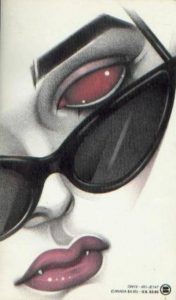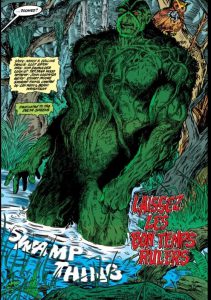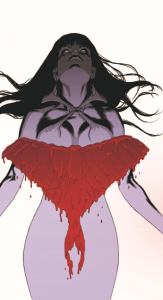by Melanie Crew
Managing Editor
Nancy A. Collins, award-winning multi-genre author, will be joining a sinister line-up of horrorific guests during Monsterama Convention’s sixth frightening rotation around the sun! Monsterama, co-chaired by our classic monster-lovin’ fiend, friend and Kool Kat Anthony Taylor, creeps into the Atlanta Marriott Alpharetta this weekend, Friday – Sunday (Sept. 27-29)!
Prepare for a ghastly weekend of ghoulish proportions including a guest list filled to the blood-curdling brim with chillers like actor Ian Ogilvy [RETURN OF THE SAINT (78-79); DEATH BECOMES HER (1992); THE SORCERERS (1967)]; actress Jane Merrow [THE SAINT (1965); THE PRISONER (1967); THE AVENGERS (1967)]; actress Pauline Peart [THE SATANIC RITES OF DRACULA (1973); CUBA (1979)]; comic artist Craig Hamilton; author Jeff Strand [EVERYTHING HAS TEETH; FEROCIOUS; BLISTER]; creaturific artist Kool Kat Mark Maddox; Victorian chamber metal musicians Valentine Wolfe; Kool Kat Shane Morton, ghost host with the most, a.k.a. Professor Morte; glamour ghoul Kool Kat Madeline Brumby and so many more! Get wicked with our Kool Kat Nancy A. Collins and haunt on down to MONSTERAMA for a weekend of monster madness!
Collins’s writing career spans 30+ years as a spinner of wild monstrous tales in novels, comic books and short stories. She brought her infamous character Sonja Blue to life in her first novel SUNGLASSES AFTER DARK in 1989, which went on to win the Bram Stoker Award for best first novel. Collins expanded the Sonja Blue universe with several sequels and is currently working on new dark adventures for her infamous goth-punk vampire/vampire hunter character. Collins is the only woman to pen DC/Vertigo’s SWAMP THING, bringing much-needed  controversy to Swamp Thing’s predominantly male perspective, from 1991 to 1993. In 2014, Collins was the first woman to be asked to write VAMPIRELLA, again giving the well-known character a new outlook with untapped new monstrous story lines and more.
controversy to Swamp Thing’s predominantly male perspective, from 1991 to 1993. In 2014, Collins was the first woman to be asked to write VAMPIRELLA, again giving the well-known character a new outlook with untapped new monstrous story lines and more.
ATLRetro caught up with Nancy A. Collins for a quick interview to talk comics; being drawn to monsters; killing it in a generally male-driven industries; and the monster mayhem of being a guest at MONSTERAMA!
ATLRetro: Your debut horror novel Sunglasses After Dark [goth-punk vampire goodness featuring kick-ass vampire/vampire hunter Sonja Blue] was released in 1989 and won the Bram Stoker Award. Can you tell us what inspired you to go against the grain and create your own style of vampire?
Nancy A. Collins: SUNGLASSES AFTER DARK was, in many ways, a middle finger to the then-current best-selling VAMPIRE CHRONICLES series by Anne Rice. It was my revolt against the “pussification” of the vampire. Little did I know that it would get even worse, decades later, with the TWILIGHT series.
Following your debut, you released several others in the series [IN THE BLOOD (1991); PAINT IT BLACK (1995); A DOZEN BLACK ROSES (1996); THE DARKEST HEART (2002); and a collection titled DEAD ROSES FOR A BLUE LADY in 2002], all followed by vignettes and novellas and comics. Basically, you’ve kept Sonja Blue “alive” and kicking for a hellacious thirty years! Any exciting new horrors coming our way in the land of Sonja Blue?
Well, I’ve been working on a new Sonja Blue novel called Kill City for the last five years. It’s a reaction to the most recent “de-fanging” of the vampire genre. Unfortunately, it’s been slow going due to my need to work paying gigs to keep body and soul together. But I would describe it as a cross between THE BIG SLEEP, HARDCORE, and THE SEARCHERS, but with vampires. And it’s the first novel to be told from Sonja Blue’s POV.
On to your monsterific comic book endeavors! From SWAMP THING, to JASON VS. LEATHERFACE, to VAMPIRELLA and beyond, you’ve delved deep into the land of what once was a male-dominated field. Can you tell our readers how you broke the barrier and what obstacles you had to face that your male counterparts avoided?
I landed the gig writing SWAMP THING largely for three reasons: DC was looking for a horror writer to take the character back to his “roots” (pun intended); I’d worked with the then-new editor on the book, Stuart Moore, on a Freddy Krueger prose anthology, and he put me on his short list because he’d had the fewest edits on my story; and, I was living in New Orleans at the time, and was able to provide local flavor. I was the first woman to write for SWAMP THING, and to date the only one, as well. For the most part, I did not run into any real obstacles regarding my gender among the editors and staff at DC. Most of the push-back I got was from the fans, many of whom did not appreciate or understand my focus on Swamp Thing as a “family man” and the emphasis on his family. I also received some blowback for depicting LGBTQ characters and depicting ecologically-driven protestors as something besides terrorists. I remember a particularly virulent letter from a fan who resented my depiction of abortion as a fact-of-life for many women. I also got a lot of hate for ending Swamp Thing and Abby’s marriage (an editorial edict, btw), for which some fans have still not forgiven me, decades later. However, DC/Vertigo is releasing my entire run on Swamp Thing in early 2020 in a hardcover omnibus format—nearly 1,000 pages—called the SWAMP THING BY NANCY COLLINS OMNIBUS. It’s currently available for pre-order through Diamond Distribution and Amazon, among other outlets.
What was it like to be the first woman writing Vampirella, a character created by the one and only Forrest J. Ackerman? There’s got to be an interesting story about how you landed that gig. Care to share?
I ended up writing VAMPIRELLA largely due to Gail Simone, who asked me to write a story for her RED SONJA miniseries “Legends of Red Sonja” for Dynamite. It was my first comic story in fifteen years. I then pitched Nick Barrucci a Red Sonja one-shot called “Berserker,” which sold extremely well. Then Nick offered me VAMPIRELLA and allowed me free reign. As one of my mentors at DC Comics had been the late Archie Goodwin, one of the first real writers on VAMPIRELLA, I always felt he was looking over my shoulder the whole time I was working on the book. I’d like to think Archie would have approved.
Can you tell us one thing you did with the character, stepping away from the usual male-created female characters, to bring her into the twenty-first century, a character both men and women would be drawn to and proud of?
I often joke that I was probably the first writer on the series to never pleasure themselves to the character, which might have something to do with how I approached my run. I chose to reach back to characters from the original Warren run and incorporate them via modern storytelling into the series’ continuity. I also made the decision to make Vampirella a more integral part of the supernatural world by bringing in classic “monsters” from myth, legend, and the public domain, and expanded on her family and backstory. I also gave her a werewolf boyfriend and depicted their relationship as that of equal partners. Vampirella in my series is a no-nonsense monster-hunter with a well-defined sense of right and wrong but is also capable of recognizing her own prejudices and misconceptions regarding her fellow “monsters”.
What can you share about your current collaboration with comic artist Craig Hamilton? Anything monstrous and exciting being brought to life?
Craig Hamilton and I, along with inker Larry Welch and colorist Gerhard, are working on BECOMING FRANKENSTEIN, a six-issue graphic series from Mel Smith’s Wild Card Ink. It is a prequel, of sorts, to Mary Shelley’s Frankenstein. I’m not allowed to say much more than that, for the time being. But I will say that Craig’s art on it is absolutely gorgeous and we’re intensely proud and excited of what we’re creating. Becoming Frankenstein is shaping up to be best work of both our careers.
Before you became “Author Nancy A. Collins,” what inspired you to write? Did you begin writing as a child?
I’ve always been a storyteller. Even before I could read and write, I would draw stories and stand next to my parents and explain what was going on. It was a given from the age of three that I would eventually become a writer. Marked from birth, I guess you could say.
Have you always been drawn to monsters? Care to share your favorite monster or horror story? What makes that story special to you?
Like I said, I was marked from birth. My maternal grandfather was a huge Boris Karloff fan, and introduced me to the genre very early. It also helped that I grew up in the 1960s, when monster mania was percolating in the kid subculture with stuff like THE ADAMS FAMILY, THE MUNSTERS, Hammer Films, late night horror movie hosts, and GODZILLA flicks. It is hard for me to pick a favorite monster or horror story, but the first one that I can remember was a Dr. Seuss story about a pair of green pants with nobody in them that walked around on their own, which scared the bejesus out of me as a 3-year-old, for some reason.
Which writer from the past and which writer from the present have influenced and continue to influence you the most, and what is it about them that draws them to you?
There have been so many. But of the past, I would have t0 say Robert Bloch, who I would later meet as a young writer. Bob befriended me and was like a second grandfather. I devoured his short story collections, which are routinely excellent and the yardstick I use for what I consider makes a great short story, especially when it comes to weird/dark fiction.
Not only are you a killer storyteller, but you’re also a spooky horror film junkie and fanatic like us! Can you tell us your favorite horror movie and why it ranks at the top of your list?
I would have to say my favorite remains the original THE HAUNTING from 1963. It is a textbook example of how the viewer’s own mind can create far more intense scares than a room full of CGI technicians. Even after all this time, I still get goosebumps watching it.
 As a writer working in the science-fiction, urban fantasy and horror genres, what challenges have you personally faced that seem to be a common theme amongst women in the industry?
As a writer working in the science-fiction, urban fantasy and horror genres, what challenges have you personally faced that seem to be a common theme amongst women in the industry?
Mostly being pigeonholed. I’ve written westerns, Southern Gothics, erotica, crime noir, urban fantasy, as well as horror—but I largely get described as a “vampire writer”, and that has become a largely female-centric field, in a lot of people’s minds. I also find myself labeled a “Strong Woman”, which is the nice way of saying I’ve had to put up with a lot of bullshit that male writers rarely are subjected to.
Can you give us five things you’re into at the moment that we should be watching, reading or listening to right now— past or present, well-known or obscure?
I’m currently enjoying the final season of PREACHER on FX, as well as the third and final season of LEGION, also on FX. I’ve also been binging THE BOYS on Prime. I also recommend GENTLEMAN JACK; a historical romance/drama on HBO about Anne Lister, an actual Regency-era noblewoman who lived openly as a lesbian, and even went so far as to marry another woman. And I always recommend watching THE VENTURE BROTHERS, regardless of the situation.
Any advice for women writers out there trying to get their foot in the door?
I have the same advice I give everyone, regardless. Keep submitting your stuff. Learn to tell the difference between legitimate criticism and bullshit. Nothing you write is carved in stone. Never fight with an editor. Never respond to the reviews on Amazon.
Getting back to what brought us here, MONSTERAMA 2019! Do you have anything exciting planned for our readers this year?
I’m hoping we’ll have the full-color promo posters for BECOMING FRANKENSTEIN ready in time for MONSTERAMA! If so, Craig Hamilton and I will be there signing them. And I’ll be on several panels over the weekend. The first is 6pm Friday, where I discuss Swamp Thing. The second is 10am Saturday, where I’ll be on a Southern Gothic panel, and the third is 10am Sunday, where I’ll be yacking about werewolves. Otherwise, I’ll be at my table in the dealer’s room.






